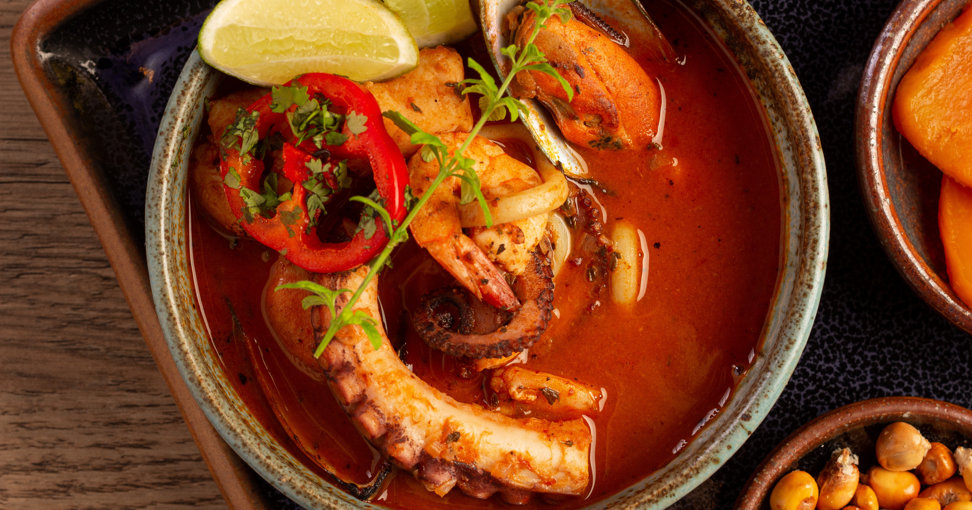Parihuela: peruvian fish and seafood soup

Origin and history of parihuela soup
Parihuela is a traditional recipe that dates back to pre-Hispanic times and forms part of Peru’s rich culinary heritage. Both the port of Callao and the district of Chorrillos claim the creation of this dish, though Callao is the place most recognized for its preparation and popularization. This port, located just 15 kilometers from Lima, is one of the country’s oldest and most important, with a history that goes back to colonial times.
During the Viceroyalty of Peru, Callao became the main maritime port of the South Pacific and was considered one of the most strategic and active ports in the Americas due to its geographical location and its role in trade between Spain and its colonies. Its commercial and fishing activity contributed to the development of traditional dishes based on local marine resources, such as parihuela, which originated as an energizing and nutritious food for the fishermen who worked daily at sea. Meanwhile, Chorrillos, another historic seaside resort and port to the south of Lima, also preserves the tradition of this seafood soup, offering its own variations that reflect the culinary diversity of Peru’s coastline.
Meaning of the name and tradition
The name “Parihuela” comes from the practice of local fishermen who used parihuelas—rustic wooden frames used to carry and display seafood—during their fishing journeys. These parihuelas, often worn from constant use, were where the fish and shellfish were laid out for sale. The soup takes its name from this tradition, highlighting its deep connection with the fishing culture of Callao.
Ingredients and Nutritional Benefits
Parihuela is a hearty broth made with fish and fresh shellfish, ingredients rich in phosphorus, protein, and essential minerals. Due to its high nutritional value, this soup has traditionally been regarded as an energizing and revitalizing dish, ideal for restoring strength after a long day’s work—especially for fishermen.
Regions where parihuela is consumed
Although Parihuela is especially emblematic in the port of Callao and in the Chorrillos district, its popularity extends throughout the Peruvian coast, particularly in cities with strong fishing traditions such as Pisco, Paracas, and Máncora. In these areas, the soup is made with fresh Pacific seafood and is a common dish in restaurants specializing in marine cuisine. In Lima as well, thanks to its gastronomic diversity and proximity to the sea, parihuela is highly appreciated both in traditional eateries and fine-dining restaurants, keeping the tradition and authentic flavor of this ancestral dish alive.
A Dish that Celebrates Peru’s Marine and Cultural Richness
Parihuela is much more than just a traditional Peruvian dish; it is a reflection of the country’s marine and cultural wealth, blending fresh ingredients and ancestral techniques to offer a unique and comforting flavor. Perfect for those looking to enjoy a nutritious meal full of history, this soup remains a symbol of the culinary legacy of Peru’s coast—especially in Callao, where its flavor and tradition live on in every spoonful.
RECIPE
Ingredients:
- ½ kg shrimp
- ¼ kg prawns
- 1 dozen mussels
- 1 dozen scallops
- ½ kg squid
- 1 kg fish
- 4 garlic cloves
- 1 onion
- 1 tomato
- 2 tablespoons ground yellow chili pepper (ají amarillo)
- 2 tablespoons ground red chili pepper (ají panca)
- Parsley, cilantro, and rosemary
Preparation:
Wash the scallops thoroughly, peel the prawns, and clean the shrimp and mussels. Cut the fish into medium pieces. Season the seafood and fish with salt, pepper, and ground yellow chili pepper.
In a pot, boil two liters of water with the fish head and mussels to prepare a rich broth. Remove the mussels, blend and strain the broth to obtain a clear, flavorful liquid.
In another pot, prepare a base by sautéing minced garlic, chopped onion, and ground red chili pepper until fragrant.
Add the scallops, prawns, shrimp, and seasoned fish pieces to the base. Stir gently.
Add the tomato paste and the strained broth. Stir in ground cilantro, rosemary, and oregano to enhance the flavor.
Cook over medium heat for a few minutes, until the seafood is well cooked and the soup has thickened.
Finally, sprinkle chopped parsley before serving to add freshness and color.
SOURCE:
Peruvian Cuisin: History, Culture, and Flavors
Autor: Sara Beatriz Guardia
USMP